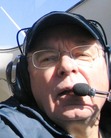Jim Poling Sr.'s Blog, page 59
April 16, 2011
Crap from Abroad
ABC TV News had a campaign earlier this year to show viewers they should be buying more goods made in America. They stripped from one family's house everything that was made abroad and replaced it with furniture and other goods made in America. They showed how doing this would put more Americans to work.
Canadians also buy too much stuff from overseas. And, as all of us have discovered, much of it is cheap crap.
My wife and I looked for months for a small towel cabinet for our cottage. We needed it to be white and a very specific size. Finally, we found one last week at a big box store. The display model had a broken leg, which I assumed was from having been dropped.
Assembly of such things can be a nightmare. Instructions are poorly done, the engineering sometimes is rough and things never go together as easily as expected.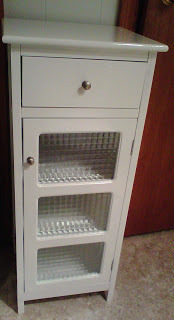 Don't Buy ItThis piece was a nightmare. The English instructions were not too bad. However, one step was missing. The leg broke just like the one at the store. Hairline cracks developed on the glossy enamel paint whenever I went near the thing. The problem was the wood was total crap. What appeared to be solid wood was pieces glued together. The screws were slightly too big and caused the heavily lacquered finish to crack where the pieces were glued. I improvised and got the thing together, somewhat scarred. Wood filler and paint did the rest.
Don't Buy ItThis piece was a nightmare. The English instructions were not too bad. However, one step was missing. The leg broke just like the one at the store. Hairline cracks developed on the glossy enamel paint whenever I went near the thing. The problem was the wood was total crap. What appeared to be solid wood was pieces glued together. The screws were slightly too big and caused the heavily lacquered finish to crack where the pieces were glued. I improvised and got the thing together, somewhat scarred. Wood filler and paint did the rest.
Normally I would have bundled up the pieces and brought them back to the store for a refund. However, I persevered because the piece was not expected to be fine furniture for the living room, and we had not been able to find anything like it in weeks of searching.
The piece was a small towel tower made by Jen Lea Inc. Model number PB40000ZWHF. Imported by Soskin and Gordon. Don't buy it.
The experience showed me three things:
1. Big store buyers consult only their calculators when bulk buying abroad. They don't spent one second on quality issues or anything else.2. Consumer protection agencies can do little considering the amount of stuff coming in from abroad. Yeah, they catch little toys that contain lead that harms babies, but that's about it.3. We buy way too much stuff from overseas and should start looking for more of our goods closer to home.
Yes, we do need to import for balance of trade etc. etc. Yes, there is demand for lower-price stuff that people can afford. But we do need to back off imports, create more jobs here, and demand better quality on goods coming into the country.
Canadians also buy too much stuff from overseas. And, as all of us have discovered, much of it is cheap crap.
My wife and I looked for months for a small towel cabinet for our cottage. We needed it to be white and a very specific size. Finally, we found one last week at a big box store. The display model had a broken leg, which I assumed was from having been dropped.
Assembly of such things can be a nightmare. Instructions are poorly done, the engineering sometimes is rough and things never go together as easily as expected.
 Don't Buy ItThis piece was a nightmare. The English instructions were not too bad. However, one step was missing. The leg broke just like the one at the store. Hairline cracks developed on the glossy enamel paint whenever I went near the thing. The problem was the wood was total crap. What appeared to be solid wood was pieces glued together. The screws were slightly too big and caused the heavily lacquered finish to crack where the pieces were glued. I improvised and got the thing together, somewhat scarred. Wood filler and paint did the rest.
Don't Buy ItThis piece was a nightmare. The English instructions were not too bad. However, one step was missing. The leg broke just like the one at the store. Hairline cracks developed on the glossy enamel paint whenever I went near the thing. The problem was the wood was total crap. What appeared to be solid wood was pieces glued together. The screws were slightly too big and caused the heavily lacquered finish to crack where the pieces were glued. I improvised and got the thing together, somewhat scarred. Wood filler and paint did the rest.Normally I would have bundled up the pieces and brought them back to the store for a refund. However, I persevered because the piece was not expected to be fine furniture for the living room, and we had not been able to find anything like it in weeks of searching.
The piece was a small towel tower made by Jen Lea Inc. Model number PB40000ZWHF. Imported by Soskin and Gordon. Don't buy it.
The experience showed me three things:
1. Big store buyers consult only their calculators when bulk buying abroad. They don't spent one second on quality issues or anything else.2. Consumer protection agencies can do little considering the amount of stuff coming in from abroad. Yeah, they catch little toys that contain lead that harms babies, but that's about it.3. We buy way too much stuff from overseas and should start looking for more of our goods closer to home.
Yes, we do need to import for balance of trade etc. etc. Yes, there is demand for lower-price stuff that people can afford. But we do need to back off imports, create more jobs here, and demand better quality on goods coming into the country.
Published on April 16, 2011 17:08
April 13, 2011
Terry Fox and the Election Debate
I dreamed last night that during the Great Federal Election Debate, Terry Fox, wearing trademark t-shirt and running shorts, limped onto the set and stared each leader in the eye. In return, they stared at the floor and shuffled their feet.
Debate day was the 31st anniversary of the Marathon of Hope, in which Terry Fox endured exhaustion and pain to do something worthwhile for millions of people. Canada has had few visible heroes since. There are heroes working quietly in fields such as medicine, education, and in family life, but certainly not in politics.
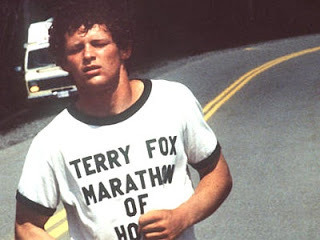 ImagineIn my dream I wished that Terry's appearance would cause the leaders to throw away their notes and step forward individually and declare: "Here are the problems we face in our country. Here is how I believe we can tackle them. Whatever the outcome of the election I'll work with other leaders, and all Canadians, to make things better for all of us."
ImagineIn my dream I wished that Terry's appearance would cause the leaders to throw away their notes and step forward individually and declare: "Here are the problems we face in our country. Here is how I believe we can tackle them. Whatever the outcome of the election I'll work with other leaders, and all Canadians, to make things better for all of us."
That didn't happen, of course, even in my dream. That's because politicians follow the polls and their spin masters, in the greedy pursuit of party power. Terry Fox followed his heart, concentrating on the next kilometre of pavement ahead. One more kilometre, one more small contribution to the common good.
Imagine if the politicians had decided to cancel the debates and focus all that energy, money and talk on the specific problems that need solving in this country. One focussed, painful step at a time down the centre line of the road that leads to a better place for all of us.
Imagine.
Debate day was the 31st anniversary of the Marathon of Hope, in which Terry Fox endured exhaustion and pain to do something worthwhile for millions of people. Canada has had few visible heroes since. There are heroes working quietly in fields such as medicine, education, and in family life, but certainly not in politics.
 ImagineIn my dream I wished that Terry's appearance would cause the leaders to throw away their notes and step forward individually and declare: "Here are the problems we face in our country. Here is how I believe we can tackle them. Whatever the outcome of the election I'll work with other leaders, and all Canadians, to make things better for all of us."
ImagineIn my dream I wished that Terry's appearance would cause the leaders to throw away their notes and step forward individually and declare: "Here are the problems we face in our country. Here is how I believe we can tackle them. Whatever the outcome of the election I'll work with other leaders, and all Canadians, to make things better for all of us."That didn't happen, of course, even in my dream. That's because politicians follow the polls and their spin masters, in the greedy pursuit of party power. Terry Fox followed his heart, concentrating on the next kilometre of pavement ahead. One more kilometre, one more small contribution to the common good.
Imagine if the politicians had decided to cancel the debates and focus all that energy, money and talk on the specific problems that need solving in this country. One focussed, painful step at a time down the centre line of the road that leads to a better place for all of us.
Imagine.
Published on April 13, 2011 07:05
April 9, 2011
Smart as a Fox
I'm getting used to typing in the semi-darkness. The sunny days are the best because the sunlight streams through the windows and onto my computer keyboard. But those dark and rainy days make seeing to type much more difficult.
I've stopped turning the lights on now that my new Smart Meter is up and running. It's supposed to help me lower my power consumption. What it has lowered is my bank account.
My latest cottage power bill is close to $1,300 for three months. Yeah, just over $400 a month. I can lease a car for that and live in it.
The Smart Meter says that we used 72 kilowatts of power every day at the cottage December through February. Odd because during the same period last year, we used 10 kilowatts a day. In fact the most we ever have used at the cottage, taken on average, is around 50 kilowatts a day. This winter we were at the cottage the same amount of time, and had the electric heat turned lower; in most cases just set above zero Celsius to prevent freezing. We use wood to heat the place.
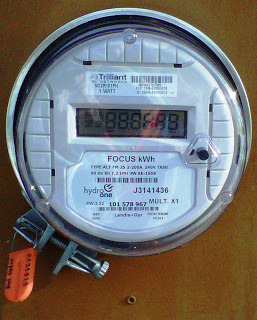 Smart, like Al CaponeAs expected, a call to Hydro One, or whatever Ontario Hydro is called these days, got us nowhere. Basically, the reply was: "You used it, you pay for it." The standard response to complaints about high power bills is that the old meters were not accurate, and the new Smart Meters are. Yeah, okay, I get it.
Smart, like Al CaponeAs expected, a call to Hydro One, or whatever Ontario Hydro is called these days, got us nowhere. Basically, the reply was: "You used it, you pay for it." The standard response to complaints about high power bills is that the old meters were not accurate, and the new Smart Meters are. Yeah, okay, I get it.
I did get an explanation of the 555 kilowatt hours that I was charged for, but did not use. Power apparently leaks from hydro lines before it gets to your place. They estimate the leakage and charge you for it.
The complaints, and the responses, are not confined to Ontario. Higher bills from Smart Meters have prompted thousands of complaints in California, British Columbia and anywhere else they have been introduced.
The power companies, however, say tens of thousands of people are wrong. Smart Meters are more accurate and save you money. I'll remember that while I'm saving to pay the $1,300 bill.
I've stopped turning the lights on now that my new Smart Meter is up and running. It's supposed to help me lower my power consumption. What it has lowered is my bank account.
My latest cottage power bill is close to $1,300 for three months. Yeah, just over $400 a month. I can lease a car for that and live in it.
The Smart Meter says that we used 72 kilowatts of power every day at the cottage December through February. Odd because during the same period last year, we used 10 kilowatts a day. In fact the most we ever have used at the cottage, taken on average, is around 50 kilowatts a day. This winter we were at the cottage the same amount of time, and had the electric heat turned lower; in most cases just set above zero Celsius to prevent freezing. We use wood to heat the place.
 Smart, like Al CaponeAs expected, a call to Hydro One, or whatever Ontario Hydro is called these days, got us nowhere. Basically, the reply was: "You used it, you pay for it." The standard response to complaints about high power bills is that the old meters were not accurate, and the new Smart Meters are. Yeah, okay, I get it.
Smart, like Al CaponeAs expected, a call to Hydro One, or whatever Ontario Hydro is called these days, got us nowhere. Basically, the reply was: "You used it, you pay for it." The standard response to complaints about high power bills is that the old meters were not accurate, and the new Smart Meters are. Yeah, okay, I get it.I did get an explanation of the 555 kilowatt hours that I was charged for, but did not use. Power apparently leaks from hydro lines before it gets to your place. They estimate the leakage and charge you for it.
The complaints, and the responses, are not confined to Ontario. Higher bills from Smart Meters have prompted thousands of complaints in California, British Columbia and anywhere else they have been introduced.
The power companies, however, say tens of thousands of people are wrong. Smart Meters are more accurate and save you money. I'll remember that while I'm saving to pay the $1,300 bill.
Published on April 09, 2011 06:20
April 5, 2011
Walking through Dorset
Something cool has happened at Dorset since the weather got warmer. That's Dorset, Ontario (not England), the little village on the east side of Lake of Bays. It's well known by cottagers, boaters, snowmobilers and tourists passing through.
Folks there have come up with a walking tour that highlights the village's rich history, a lot of which is not known to the many people who visit it regularly.
Dorset began in the 1800s with a trading post established by Francis Harvey. Thus the names Trading Bay and Harvey Street. It boomed during the lumbering years, a highlight of which was the incredible Gilmour Tramway that carried logs from Dorset over the hills, down into Raven Lake, along the Black River, then into a small manmade canal carrying them into St. Nora Lake enroute to Trenton on Lake Ontario.
The walking tour starts at the little park on the inner bay, goes across the Highway 35 bridge, down Harvey Avenue, left at the Post Office, up the hill and down past the Dorset Garage and the big yellow house, then back down Main Street, ending at the museum.
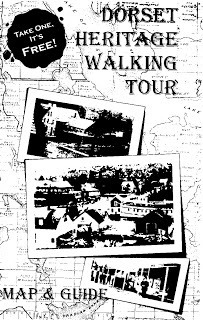 The tour provides some interesting facts, such as: The little hill up past the Anglican church is known as Pill Hill because that's where the pharmacy used to be. The yellow house is Lockman House and was the original office of the Gilmour Lumber Company.
The tour provides some interesting facts, such as: The little hill up past the Anglican church is known as Pill Hill because that's where the pharmacy used to be. The yellow house is Lockman House and was the original office of the Gilmour Lumber Company.
Another neat fact: In 1883, Dorset's first postmaster, Allen Phillips, used to canoe from Dorset to Baysville to pick up the mail. His salary was $50 a year.
The walk, and the brochure that goes with it, are free. Neat stuff about one of the country's neatest places!
Congratulations to the folks who came up with the idea and who put it all together.

Folks there have come up with a walking tour that highlights the village's rich history, a lot of which is not known to the many people who visit it regularly.
Dorset began in the 1800s with a trading post established by Francis Harvey. Thus the names Trading Bay and Harvey Street. It boomed during the lumbering years, a highlight of which was the incredible Gilmour Tramway that carried logs from Dorset over the hills, down into Raven Lake, along the Black River, then into a small manmade canal carrying them into St. Nora Lake enroute to Trenton on Lake Ontario.
The walking tour starts at the little park on the inner bay, goes across the Highway 35 bridge, down Harvey Avenue, left at the Post Office, up the hill and down past the Dorset Garage and the big yellow house, then back down Main Street, ending at the museum.
 The tour provides some interesting facts, such as: The little hill up past the Anglican church is known as Pill Hill because that's where the pharmacy used to be. The yellow house is Lockman House and was the original office of the Gilmour Lumber Company.
The tour provides some interesting facts, such as: The little hill up past the Anglican church is known as Pill Hill because that's where the pharmacy used to be. The yellow house is Lockman House and was the original office of the Gilmour Lumber Company.Another neat fact: In 1883, Dorset's first postmaster, Allen Phillips, used to canoe from Dorset to Baysville to pick up the mail. His salary was $50 a year.
The walk, and the brochure that goes with it, are free. Neat stuff about one of the country's neatest places!
Congratulations to the folks who came up with the idea and who put it all together.
Published on April 05, 2011 19:54
April 2, 2011
Losing Virgin America
We're riding one of the last Virgin America flights between the United States and Canada. Pity.
Virgin found flying in and out of Toronto too pricey, so has decided to move Toronto ops to Dallas next week. Can't blame them. My ticket Toronto-San Francisco return was $350 of which one-third was taxes and fees. I don't know how much Virgin had to pay for airport landing fees but I'm told Toronto is one of the most expensive airports for an airline to operate from.
With Virgin gone, that means higher fares for Toronto-California trips. Air Canada had been matching Virgin's fares but now is charging more than $600 for the same flight. Surprise!
I was once an Air Canada high mileage flyer but haven't boarded them in years. Got tired of the high prices and being made to feel like an imposition.
For some years now, I've been flying out of Buffalo-Niagara airport, usually on Southwest. Fares are much cheaper and SWA is more of a fun ride with friendly crew and relaxed atmosphere. More than one-half of the licence plates in Buffalo-Niagara parking lots say Ontario. Parking is much cheaper there than in Toronto. I've even done Canadian destinations from Buffalo. Usually means connections, but what's the hurry?
Virgin was a nice ride, while it lasted. Leather seats, reasonable amount of leg room. Bring your own lunch or order something off the computer screen at your seat. The blue and pink interior lighting makes the cabin feel like a 1960s cocktail lounge, but some people probably like that.
"Toronto's loss will be Dallas/Fort Worth International Airport's gain," the Dallas Morning News reports gleefully. And, Buffalo's. How many tens of millions of dollars is Buffalo-Airport draining out of Toronto? Must be huge.
Hey tax me, I'm Canadian. Not when I can find a way to avoid it.
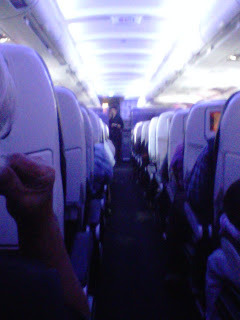 Virgin - Weird Lighting, Good Fares
Virgin - Weird Lighting, Good Fares

Virgin found flying in and out of Toronto too pricey, so has decided to move Toronto ops to Dallas next week. Can't blame them. My ticket Toronto-San Francisco return was $350 of which one-third was taxes and fees. I don't know how much Virgin had to pay for airport landing fees but I'm told Toronto is one of the most expensive airports for an airline to operate from.
With Virgin gone, that means higher fares for Toronto-California trips. Air Canada had been matching Virgin's fares but now is charging more than $600 for the same flight. Surprise!
I was once an Air Canada high mileage flyer but haven't boarded them in years. Got tired of the high prices and being made to feel like an imposition.
For some years now, I've been flying out of Buffalo-Niagara airport, usually on Southwest. Fares are much cheaper and SWA is more of a fun ride with friendly crew and relaxed atmosphere. More than one-half of the licence plates in Buffalo-Niagara parking lots say Ontario. Parking is much cheaper there than in Toronto. I've even done Canadian destinations from Buffalo. Usually means connections, but what's the hurry?
Virgin was a nice ride, while it lasted. Leather seats, reasonable amount of leg room. Bring your own lunch or order something off the computer screen at your seat. The blue and pink interior lighting makes the cabin feel like a 1960s cocktail lounge, but some people probably like that.
"Toronto's loss will be Dallas/Fort Worth International Airport's gain," the Dallas Morning News reports gleefully. And, Buffalo's. How many tens of millions of dollars is Buffalo-Airport draining out of Toronto? Must be huge.
Hey tax me, I'm Canadian. Not when I can find a way to avoid it.
 Virgin - Weird Lighting, Good Fares
Virgin - Weird Lighting, Good Fares
Published on April 02, 2011 06:45
March 30, 2011
Goodbye California
Now that the sun is shining, we are out of here. Two weeks of rain, and now clear skies and temps in the 70s. One of wettest springs in memory in the San Francisco Bay area. The average annual rainfall here is just shy of two feet, amost all of it November through March.
Winter rain isn't a big deal on the northern California coast. Folks do what they normally do, wet or dry. We lived three years in Vancouver, so we get it.
Maybe it's the winter rains that give California its character. And, individual character it does have. Individualism is celebrated everywhere. You see it in the architecture. Many of the homes, new and old, are custom built. There are few noticeable cookie-cutter subdivisions.
The best examples of individualism are seen in homes built in the steepest spots. One place, farther up the hill here in Orinda, is so short of flat land that they built the garage on top of the house. Cars parked in garages above living rooms or bedrooms are not uncommon here.
The hundreds of thousands of people scattered across these hills live in the shadows of a number of natural disasters. Wildfires in the summer dry season, landslides in the rainy season, and of course earthquakes. I sit typing now directly over the San Andreas fault.
It's easy to forget about these terrors because it is so pleasant here. I sit out in the backyard and look across the valley to Orinda village and listen to bells and chimes coming from Santa Maria church. It's a Spanish-style mission, as are many of the Catholic churches here, and they still have nuns in habits.
Behind me, way up on Grizzly Peak, is a stunning view of the entire Bay area. Down below to the right is Berkeley. Not many nuns in habits evident there, but lots of good bookstores and pubs.
One thing that strikes you on this side of the mountain is there are no huge malls and big box stores and chain eateries, in sight. Just wooded hills, with houses and towns where most of the shops and places to eat are small and owned by individuals. In some of these small towns even the original movie theatres stand in prominent spots, still operating.
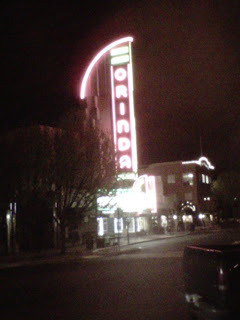 Orinda's art-deco movie house opened 1941Now that rains have ceased, people are outside. They have flocked to Lamorinda Reservoir where there is a three-mile walking trail, fishing and paddle boats for hire. You can imagine the activity that will be here when the hot weather arrives.
Orinda's art-deco movie house opened 1941Now that rains have ceased, people are outside. They have flocked to Lamorinda Reservoir where there is a three-mile walking trail, fishing and paddle boats for hire. You can imagine the activity that will be here when the hot weather arrives.
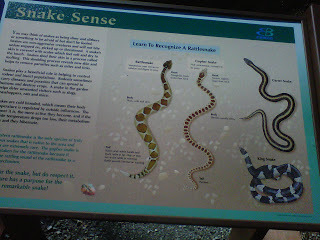
A sign along the walking trail tells me it definitely is time for me to leave. The sign is all about snakes that become active when the weather warms. There are rattlesnakes but the sign says they are seldom seen. Oh, yeah. Goodbye California.
Winter rain isn't a big deal on the northern California coast. Folks do what they normally do, wet or dry. We lived three years in Vancouver, so we get it.
Maybe it's the winter rains that give California its character. And, individual character it does have. Individualism is celebrated everywhere. You see it in the architecture. Many of the homes, new and old, are custom built. There are few noticeable cookie-cutter subdivisions.
The best examples of individualism are seen in homes built in the steepest spots. One place, farther up the hill here in Orinda, is so short of flat land that they built the garage on top of the house. Cars parked in garages above living rooms or bedrooms are not uncommon here.
The hundreds of thousands of people scattered across these hills live in the shadows of a number of natural disasters. Wildfires in the summer dry season, landslides in the rainy season, and of course earthquakes. I sit typing now directly over the San Andreas fault.
It's easy to forget about these terrors because it is so pleasant here. I sit out in the backyard and look across the valley to Orinda village and listen to bells and chimes coming from Santa Maria church. It's a Spanish-style mission, as are many of the Catholic churches here, and they still have nuns in habits.
Behind me, way up on Grizzly Peak, is a stunning view of the entire Bay area. Down below to the right is Berkeley. Not many nuns in habits evident there, but lots of good bookstores and pubs.
One thing that strikes you on this side of the mountain is there are no huge malls and big box stores and chain eateries, in sight. Just wooded hills, with houses and towns where most of the shops and places to eat are small and owned by individuals. In some of these small towns even the original movie theatres stand in prominent spots, still operating.
 Orinda's art-deco movie house opened 1941Now that rains have ceased, people are outside. They have flocked to Lamorinda Reservoir where there is a three-mile walking trail, fishing and paddle boats for hire. You can imagine the activity that will be here when the hot weather arrives.
Orinda's art-deco movie house opened 1941Now that rains have ceased, people are outside. They have flocked to Lamorinda Reservoir where there is a three-mile walking trail, fishing and paddle boats for hire. You can imagine the activity that will be here when the hot weather arrives.
A sign along the walking trail tells me it definitely is time for me to leave. The sign is all about snakes that become active when the weather warms. There are rattlesnakes but the sign says they are seldom seen. Oh, yeah. Goodbye California.
Published on March 30, 2011 20:04
March 27, 2011
A Pit of Snarling Dogs
This truly is the spring of our discontent. The weather is abnormally cool and stormy compared with last year's abnormal warmth and winter's early end, in Ontario at least. Civil wars and uprisings in the Arab world. Disasters in Japan, and elsewhere. Economic uncertainty everywhere.
Now this: A federal election that no one wants, or needs, except the politicians.
The sad truth is that the election will change nothing. The government might change, but little else will. The poor will remain, and likely increase in numbers. The middle class will continue to seek ways to overcome the burdens of rising costs and heavy taxation. The best off will continue to manipulate the system to become even more well off. The cultural gap between urban and country people will grow wider. The health care aneurysm will continue to swell until it finally ruptures.
Nothing will change until we cleanse ourselves of our vicious confrontational politics. Making the other guy look much worse than he really is -- through innuendo, spin and mind management -- has become more important than practising the arts of listening, thoughtful analysis and compromise in pursuit of common good.
The most important issue in this election is: How do we make the politicians understand and commit to doing what they are supposed to do. And that, for those who might have lost sight of it, is providing intelligent and decisive leadership without thoughts of personal gain or personal glory.
This election unfortunately is about keeping or obtaining power.
There is a possibility that fewer than 50 per cent of Canadians will vote in this election. The turnout in 2008 was only 59 per cent, and in the intervening three years more voters have become sickened by what they see of, and hear from, the politicians.
How could they not be sickened? Our politics here, and in the United States, have become a pit of snarling, backbiting dogs.
The nastiness of our so-called leaders is a national disgrace. The other day we had a senior Ignatieff adviser calling the prime minister "tin pot dictator." We have Conservative attack adds making Ignatieff look like a crazed person returning to Canada to rape and plunder.
Political rants from politicians and citizens have reached the level of hate mongering. Each time we denigrate someone, we denigrate ourselves and our system of government. Being honest and fair once was part of the Canadian identity. We lost much of that as we allowed our political discussions to sink to levels seen on the Jerry Springer Show.
Henry David Thoreau, the American essayist, wrote:
"Let every man make known what kind of government would command his respect, and that will be one step toward obtaining it." (On the Duty of Civil Disobedience 1849).
The kind of Parliament we want, and need, we have not had for a long time in Canada. When they come knocking at the door this time, tell what we want. We are disgusted with them all and want our politicians working for the people through civil and intelligent discussion.

Now this: A federal election that no one wants, or needs, except the politicians.
The sad truth is that the election will change nothing. The government might change, but little else will. The poor will remain, and likely increase in numbers. The middle class will continue to seek ways to overcome the burdens of rising costs and heavy taxation. The best off will continue to manipulate the system to become even more well off. The cultural gap between urban and country people will grow wider. The health care aneurysm will continue to swell until it finally ruptures.
Nothing will change until we cleanse ourselves of our vicious confrontational politics. Making the other guy look much worse than he really is -- through innuendo, spin and mind management -- has become more important than practising the arts of listening, thoughtful analysis and compromise in pursuit of common good.
The most important issue in this election is: How do we make the politicians understand and commit to doing what they are supposed to do. And that, for those who might have lost sight of it, is providing intelligent and decisive leadership without thoughts of personal gain or personal glory.
This election unfortunately is about keeping or obtaining power.
There is a possibility that fewer than 50 per cent of Canadians will vote in this election. The turnout in 2008 was only 59 per cent, and in the intervening three years more voters have become sickened by what they see of, and hear from, the politicians.
How could they not be sickened? Our politics here, and in the United States, have become a pit of snarling, backbiting dogs.
The nastiness of our so-called leaders is a national disgrace. The other day we had a senior Ignatieff adviser calling the prime minister "tin pot dictator." We have Conservative attack adds making Ignatieff look like a crazed person returning to Canada to rape and plunder.
Political rants from politicians and citizens have reached the level of hate mongering. Each time we denigrate someone, we denigrate ourselves and our system of government. Being honest and fair once was part of the Canadian identity. We lost much of that as we allowed our political discussions to sink to levels seen on the Jerry Springer Show.
Henry David Thoreau, the American essayist, wrote:
"Let every man make known what kind of government would command his respect, and that will be one step toward obtaining it." (On the Duty of Civil Disobedience 1849).
The kind of Parliament we want, and need, we have not had for a long time in Canada. When they come knocking at the door this time, tell what we want. We are disgusted with them all and want our politicians working for the people through civil and intelligent discussion.
Published on March 27, 2011 12:09
March 24, 2011
Beer at The Berkeley Bowl
So you think 99 bottles of beer on the wall is a big thing? You oughta see this place. Five refrigerated shelves seemingly running the length of a bowling alley. I pace it off: roughly 60 to 70 feet of five shelves filled with beers of every type.
One of the young ladies restocking the shelves notices me and instead of calling security, smiles and says: "You could come here every day for two years and you still wouldn't be able to drink it all."
Possibly not, but I have a couple golf buddies who would love to give it a try.
She tells me the shelves hold about 600 different beers. I didn't know there were that many beers in the world.
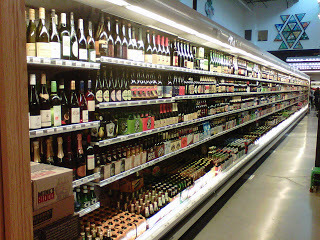 Long, Lovely Line of Beers at Berkeley Bowl WestThe Berkeley Bowl is a grocery store; a very large grocery store. I'm not sure why we are here so soon after being to Costco. I guess it's because of the rain, ever present this past week.
Long, Lovely Line of Beers at Berkeley Bowl WestThe Berkeley Bowl is a grocery store; a very large grocery store. I'm not sure why we are here so soon after being to Costco. I guess it's because of the rain, ever present this past week.
Berkeley Bowl West is a 140,000-square foot facility that includes a cafe, prep kitchen, modest wine tasting bar, warehouse and offices. It employs 250 employees, 60 of them working side by side in the main kitchen to turn out baked goods and ready-to-eat items, as well as cuisine for the cafe, which is large enough to hold a three-ring circus.
Grocer Glenn Yasuda and his wife, Diane, opened the first Berkeley Bowl in central Berkeley more than 30 years ago. It was a tiny place and they named it Berkeley Bowl because they set up shop in a former bowling alley. Now with the opening of BB West they have two.
You'll see on the shelves Big Bear Black Stout, Woodchuck Hard Cider, St. Peter's Sorgham Beer, Red Seal Ale, Hop Head Red, plus some of the more well-known brands. Some of the beer labels have only Chinese or Japanese lettering, so we're not sure what they are.
Off to one side is a special display of 64-ounce mini-kegs of Dead Guy Ale from Oregon. There have been some mornings in the long ago past when I woke up convinced that I had some of that.
Choice. That's what it's all about in the United States of America.
Why aren't we allowed to buy our beer, wine and liquor where we buy our groceries? C'mon Dalton, set the people free!
One of the young ladies restocking the shelves notices me and instead of calling security, smiles and says: "You could come here every day for two years and you still wouldn't be able to drink it all."
Possibly not, but I have a couple golf buddies who would love to give it a try.
She tells me the shelves hold about 600 different beers. I didn't know there were that many beers in the world.
 Long, Lovely Line of Beers at Berkeley Bowl WestThe Berkeley Bowl is a grocery store; a very large grocery store. I'm not sure why we are here so soon after being to Costco. I guess it's because of the rain, ever present this past week.
Long, Lovely Line of Beers at Berkeley Bowl WestThe Berkeley Bowl is a grocery store; a very large grocery store. I'm not sure why we are here so soon after being to Costco. I guess it's because of the rain, ever present this past week. Berkeley Bowl West is a 140,000-square foot facility that includes a cafe, prep kitchen, modest wine tasting bar, warehouse and offices. It employs 250 employees, 60 of them working side by side in the main kitchen to turn out baked goods and ready-to-eat items, as well as cuisine for the cafe, which is large enough to hold a three-ring circus.
Grocer Glenn Yasuda and his wife, Diane, opened the first Berkeley Bowl in central Berkeley more than 30 years ago. It was a tiny place and they named it Berkeley Bowl because they set up shop in a former bowling alley. Now with the opening of BB West they have two.
You'll see on the shelves Big Bear Black Stout, Woodchuck Hard Cider, St. Peter's Sorgham Beer, Red Seal Ale, Hop Head Red, plus some of the more well-known brands. Some of the beer labels have only Chinese or Japanese lettering, so we're not sure what they are.
Off to one side is a special display of 64-ounce mini-kegs of Dead Guy Ale from Oregon. There have been some mornings in the long ago past when I woke up convinced that I had some of that.
Choice. That's what it's all about in the United States of America.
Why aren't we allowed to buy our beer, wine and liquor where we buy our groceries? C'mon Dalton, set the people free!
Published on March 24, 2011 15:37
March 22, 2011
Dining Out at Costco
Wow, what a lunch. Started with a handful of almond mix, then went straight for the chili, followed by a Chinese-style salad. Then moved across the aisle to the pasta samples, then on to Aisle 3 for the Rocky Range chicken sausages and meatballs.
Sausage in one hand, meatball in the other, I was hotfooting it to the buffalo wings when I got a Blackberry poke from Diane.
"Incredible," she messaged. "These people really want you to eat." She was at a sushi booth which I hadn't found yet.
They really know how to feed you at Costco in the United States. I'm used to to the Canadian Costco stores where a few unsmiling ladies dish out microscopic food samples like crackers, trail mix and apple juice. You'll get your hand slapped if you come back for seconds, so sometimes when I'm really hungry I have to bring a stick-on mustache and a wig.
Here in California they encourage you to have seconds.
On our visit to Costco at Concord, just east of San Francisco, I hear the guy giving out pita bread pieces with Middle East spreads holler: "More ready here. C'mon and get it."
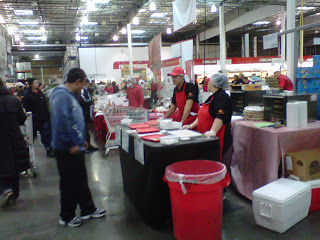 Food Sample Folks at Concord, CA CostcoThere probably are two dozen food sample setups in this store, which appears to be the same size as the Barrie, ON store that I patronize. I wonder how anyone has time to shop. They are too busy eating.
Food Sample Folks at Concord, CA CostcoThere probably are two dozen food sample setups in this store, which appears to be the same size as the Barrie, ON store that I patronize. I wonder how anyone has time to shop. They are too busy eating.
"Here try to the meatballs too," says the guy at Rocky the Range chicken. He appears to be working alone, but most tables have three, or four or more workers preparing and setting out samples. There are few lineups for the best stuff because there is plenty of it being set out as fast as it is grabbed off the tables.
By the time I've hit the corn dogs, sushi, pretzel crackers and decadent dark chocolate with walnuts, I'm looking for the free Rolaids. There aren't any, so I wander into the back corner of the building where they aren't giving out any samples. This is where they have the liquor and wine.
There are rows of it stacked head high. Did you know that Costco has its own brand liquor and wine? I pick up a bottle of Kirkland Small Batch Kentucky bourbon. There's also Kirkland vodka and on and on. And I thought they just made their own batteries.
While browsing I bump into Russell, the wine products adviser who patrols the aisles chatting to folks, answering their questions and giving them tips on the wines. He is so tall that I get a stiff neck from talking up to him. It's worth it. He tells me that Costco is the world's largest seller of wine. Period. And, it is not all plonk like the Two Buck Chuck we used to buy at Trader Joe's. Some bottles are $20.
Russell has been really nice and I hate to leave without something. So I grab two bottles of Tractor Shed Red. It's a California wine made not too far from Concord. I figure it will be nice to have a glass or two when I pull my tractor from its shed for its spring oil change. Good way to celebrate spring.
Am-ur-ica. I love it!
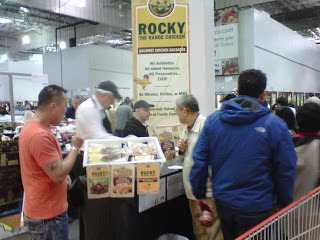 Rocky Range sausages and meatballs
Rocky Range sausages and meatballs
Sausage in one hand, meatball in the other, I was hotfooting it to the buffalo wings when I got a Blackberry poke from Diane.
"Incredible," she messaged. "These people really want you to eat." She was at a sushi booth which I hadn't found yet.
They really know how to feed you at Costco in the United States. I'm used to to the Canadian Costco stores where a few unsmiling ladies dish out microscopic food samples like crackers, trail mix and apple juice. You'll get your hand slapped if you come back for seconds, so sometimes when I'm really hungry I have to bring a stick-on mustache and a wig.
Here in California they encourage you to have seconds.
On our visit to Costco at Concord, just east of San Francisco, I hear the guy giving out pita bread pieces with Middle East spreads holler: "More ready here. C'mon and get it."
 Food Sample Folks at Concord, CA CostcoThere probably are two dozen food sample setups in this store, which appears to be the same size as the Barrie, ON store that I patronize. I wonder how anyone has time to shop. They are too busy eating.
Food Sample Folks at Concord, CA CostcoThere probably are two dozen food sample setups in this store, which appears to be the same size as the Barrie, ON store that I patronize. I wonder how anyone has time to shop. They are too busy eating."Here try to the meatballs too," says the guy at Rocky the Range chicken. He appears to be working alone, but most tables have three, or four or more workers preparing and setting out samples. There are few lineups for the best stuff because there is plenty of it being set out as fast as it is grabbed off the tables.
By the time I've hit the corn dogs, sushi, pretzel crackers and decadent dark chocolate with walnuts, I'm looking for the free Rolaids. There aren't any, so I wander into the back corner of the building where they aren't giving out any samples. This is where they have the liquor and wine.
There are rows of it stacked head high. Did you know that Costco has its own brand liquor and wine? I pick up a bottle of Kirkland Small Batch Kentucky bourbon. There's also Kirkland vodka and on and on. And I thought they just made their own batteries.
While browsing I bump into Russell, the wine products adviser who patrols the aisles chatting to folks, answering their questions and giving them tips on the wines. He is so tall that I get a stiff neck from talking up to him. It's worth it. He tells me that Costco is the world's largest seller of wine. Period. And, it is not all plonk like the Two Buck Chuck we used to buy at Trader Joe's. Some bottles are $20.
Russell has been really nice and I hate to leave without something. So I grab two bottles of Tractor Shed Red. It's a California wine made not too far from Concord. I figure it will be nice to have a glass or two when I pull my tractor from its shed for its spring oil change. Good way to celebrate spring.
Am-ur-ica. I love it!
 Rocky Range sausages and meatballs
Rocky Range sausages and meatballs
Published on March 22, 2011 07:42
March 19, 2011
Of Tims and Starbucks
The difference between Canadians and Americans is seen easily in how they take their coffee.
Travelling from Alliston to Toronto Airport the other day we passed several Tim Horton's coffee spots. It was 6 a.m. and cars were lined up in the drive-throughs at all of them . It is difficult to find a Timmies without at least one car at the window at any time of day or night. Getting a Tim's on the go is an integral part of Canadian life.
Today I'm sitting in Starbucks (Orinda, CA) having a latte and a piece of coffee cake (there was no toast). Folks are sitting at little tables with their coffee and laptops, smart phones and iPads. Some aren't wired but are chatting and reading magazines and newspapers.
Down here coffee still appears to be more of a social thing. In Canada, coffee is done mainly on the move. Go to a hockey rink and people are standing around with coffee cups in their hands. Peer into cars on the freeways and you'll see the drivers holding Timmies.
In large Canadian urban places, of course, you'll also find Starbucks packed with folks reading, communicating and computing. But that's a small number compared to those sipping a Tim's out on the highways.
I've never seen a drive-in coffee place here, or anywhere else in the U.S. that I can recall. They have drive-in liquor stores, so they must have a drive-in coffee place or two.
Whatever the coffee culture, it's certainly big business in both countries. There's a steady flow of customers into this village Starbucks. It can be difficult to get a seat at times. I guess that's why Starbucks reported almost $3 billion in revenues during the last quarter reported. Tim Hortons, with fewer outlets, and less international presence, had $2.5 billion total revenue for all four quarters in 2010.
Both coffee companies have been around roughly the same amount of time. Tim's got going 46 years ago (if you are Canadian you know that story inside out). Starbucks is celebrating its 40th anniversary, according to the stickers on the entry doors.
You can find Timmies in the U.S. There are 550 stores, a lot of them near the border. There are 3,000 stores in Canada.
Tim's has plans for more U.S, locations, so who knows, maybe the cultures will merge even more and I'll be able to drive up to a Tim's in Orinda and order a double-double.
Not a bad thought considering Starbucks prices. My latte and coffee cake cost me $5. I can get breakfast for that at my favourite breakfast spot: Old Mill Restaurant at Carnarvon in cottage country.
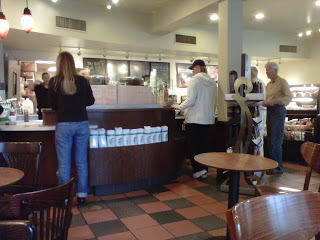 Early morning coffee customers at Starbucks in Orinda
Early morning coffee customers at Starbucks in Orinda
Travelling from Alliston to Toronto Airport the other day we passed several Tim Horton's coffee spots. It was 6 a.m. and cars were lined up in the drive-throughs at all of them . It is difficult to find a Timmies without at least one car at the window at any time of day or night. Getting a Tim's on the go is an integral part of Canadian life.
Today I'm sitting in Starbucks (Orinda, CA) having a latte and a piece of coffee cake (there was no toast). Folks are sitting at little tables with their coffee and laptops, smart phones and iPads. Some aren't wired but are chatting and reading magazines and newspapers.
Down here coffee still appears to be more of a social thing. In Canada, coffee is done mainly on the move. Go to a hockey rink and people are standing around with coffee cups in their hands. Peer into cars on the freeways and you'll see the drivers holding Timmies.
In large Canadian urban places, of course, you'll also find Starbucks packed with folks reading, communicating and computing. But that's a small number compared to those sipping a Tim's out on the highways.
I've never seen a drive-in coffee place here, or anywhere else in the U.S. that I can recall. They have drive-in liquor stores, so they must have a drive-in coffee place or two.
Whatever the coffee culture, it's certainly big business in both countries. There's a steady flow of customers into this village Starbucks. It can be difficult to get a seat at times. I guess that's why Starbucks reported almost $3 billion in revenues during the last quarter reported. Tim Hortons, with fewer outlets, and less international presence, had $2.5 billion total revenue for all four quarters in 2010.
Both coffee companies have been around roughly the same amount of time. Tim's got going 46 years ago (if you are Canadian you know that story inside out). Starbucks is celebrating its 40th anniversary, according to the stickers on the entry doors.
You can find Timmies in the U.S. There are 550 stores, a lot of them near the border. There are 3,000 stores in Canada.
Tim's has plans for more U.S, locations, so who knows, maybe the cultures will merge even more and I'll be able to drive up to a Tim's in Orinda and order a double-double.
Not a bad thought considering Starbucks prices. My latte and coffee cake cost me $5. I can get breakfast for that at my favourite breakfast spot: Old Mill Restaurant at Carnarvon in cottage country.
 Early morning coffee customers at Starbucks in Orinda
Early morning coffee customers at Starbucks in Orinda
Published on March 19, 2011 11:25

